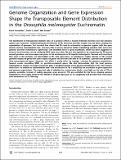| dc.contributor.author | Fontanillas, Pierre | |
| dc.contributor.author | Hartl, Daniel L. | |
| dc.contributor.author | Reuter, Max | |
| dc.contributor.author | Malik, Harmit S | |
| dc.date.accessioned | 2010-10-06T17:37:59Z | |
| dc.date.issued | 2007 | |
| dc.identifier.citation | Fontanillas, Pierre, Daniel L. Hartl, Max Reuter, and Harmit S. Malik. 2007. Genome organization and gene expression shape the transposable element distribution in the drosophila melanogaster euchromatin. PLoS Genetics 3(11): 2256-2267. | en_US |
| dc.identifier.issn | 1553-7390 | en_US |
| dc.identifier.uri | http://nrs.harvard.edu/urn-3:HUL.InstRepos:4459989 | |
| dc.description.abstract | The distribution of transposable elements (TEs) in a genome reflects a balance between insertion rate and selection against new insertions. Understanding the distribution of TEs therefore provides insights into the forces shaping the organization of genomes. Past research has shown that TEs tend to accumulate in genomic regions with low gene density and low recombination rate. However, little is known about the factors modulating insertion rates across the genome and their evolutionary significance. One candidate factor is gene expression, which has been suggested to increase local insertion rate by rendering DNA more accessible. We test this hypothesis by comparing the TE density around germline- and soma-expressed genes in the euchromatin of Drosophila melanogaster. Because only insertions that occur in the germline are transmitted to the next generation, we predicted a higher density of TEs around germline-expressed genes than soma-expressed genes. We show that the rate of TE insertions is greater near germline- than soma-expressed genes. However, this effect is partly offset by stronger selection for genome compactness (against excess noncoding DNA) on germline-expressed genes. We also demonstrate that the local genome organization in clusters of coexpressed genes plays a fundamental role in the genomic distribution of TEs. Our analysis shows that—in addition to recombination rate—the distribution of TEs is shaped by the interaction of gene expression and genome organization. The important role of selection for compactness sheds a new light on the role of TEs in genome evolution. Instead of making genomes grow passively, TEs are controlled by the forces shaping genome compactness, most likely linked to the efficiency of gene expression or its complexity and possibly their interaction with mechanisms of TE silencing. | en_US |
| dc.description.sponsorship | Organismic and Evolutionary Biology | en_US |
| dc.language.iso | en_US | en_US |
| dc.publisher | Public Library of Science | en_US |
| dc.relation.isversionof | doi:10.1371/journal.pgen.0030210 | en_US |
| dc.relation.hasversion | http://www.ncbi.nlm.nih.gov/pmc/articles/PMC2098804/pdf/ | en_US |
| dash.license | LAA | |
| dc.subject | evolutionary biology | en_US |
| dc.subject | genetics and genomics | en_US |
| dc.subject | eukaryotes | en_US |
| dc.subject | animals | en_US |
| dc.subject | arthropods | en_US |
| dc.subject | insects | en_US |
| dc.subject | drosophila | en_US |
| dc.title | Genome Organization and Gene Expression Shape the Transposable Element Distribution in the Drosophila Melanogaster Euchromatin | en_US |
| dc.type | Journal Article | en_US |
| dc.description.version | Version of Record | en_US |
| dc.relation.journal | PLoS Genetics | en_US |
| dash.depositing.author | Hartl, Daniel L. | |
| dc.date.available | 2010-10-06T17:37:59Z | |
| dc.identifier.doi | 10.1371/journal.pgen.0030210 | * |
| dash.contributor.affiliated | Hartl, Daniel | |


